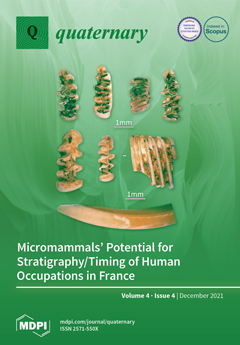The Middle Pleistocene fluvial channel site of the Upper Fossil-bearing Interval at Mata Menge in the So’a Basin, Flores, Indonesia, has yielded the earliest fossil evidence for
Homo floresiensis in association with stone artefacts and fossils of highly endemic insular fauna, including
Stegodon
[...] Read more.
The Middle Pleistocene fluvial channel site of the Upper Fossil-bearing Interval at Mata Menge in the So’a Basin, Flores, Indonesia, has yielded the earliest fossil evidence for
Homo floresiensis in association with stone artefacts and fossils of highly endemic insular fauna, including
Stegodon, giant rats, crocodiles, Komodo dragons, and various birds. A preliminary taphonomic review of the fossil material here aimed to provide additional context for the hominin remains in this bonebed. Analysis was performed on two subsets of material from the same fluvial sandstone layer. Subset 1 comprised all material from two adjacent one-metre square quadrants (
n = 91), and Subset 2 all
Stegodon long limb bones excavated from the same layer (
n = 17). Key analytical parameters included species and skeletal element identification; fossil size measurements and fragmentation; weathering stages; bone fracture characteristics; and other biological and geological bone surface modifications. Analysis of Subset 1 material identified a highly fragmented assemblage with a significant bias towards
Stegodon. A large portion of these bones were likely fractured by trampling prior to entering the fluvial channel and were transported away from the death-site, undergoing surface modification causing rounding. Subset 2 material was less likely to have been transported far based on its limited susceptibility to fluvial transport. There was no significant difference in weathering for the long limb bones and fragments, with the highest portion exhibiting Stage 2 weathering, indicating that prior to final burial, all material was exposed to prolonged periods of surface exposure. Approximately 10% of all material have characteristics of fracturing on fresh bone, contributing to the taphonomic context for this bonebed; however insufficient evidence was found for anthropogenic modification.
Full article





